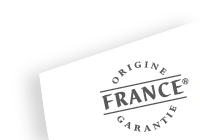
Wine vocabulary
Mastering the vocabulary of wine helps you to better understand the world of wine.
An important component of wine, there are over 35 acids: succinic, amino, carbonic, acetic, citric, lactic, malic, tartaric acids etc.…These are essential ingredients for wine since they are responsible for bringing out the aromas and flavours of the fruit.
Aerating the wine accelerates the release of all of its aromas. The reason why we expose wine to air (decant) is to accelerate the release of aromas.
Length of the tasting impression in contact with the tongue, after taste is expressed in caudalies or seconds.
Said of a young wine devoid of sweetness or a matured wine which is green.
Certification granted to French wines from geographical indications which stand out owing to the originality and quality of their production, thanks to the observance of wine growing rules established based on tradition.
Sensation éprouvée lors de la dégustation de vins très tanniques. Les tanins coagulent les protéines de la cavité buccale, ce qui entraîne une sensation de rétrécissement de la cavité buccale.
Small label attached to the opposite side of the main label, called the front label.
Sensation felt at the back of the mouth, bitterness is considered undesirable.
Said of a wine weighty in the mouth, round and well structured.
All of the olfactory sensations which result from the combination of the aromas of the grape, the secondary aromas, derived from fermentation and tertiary aromas developed through maturing.
Literally “bringing the wine to the temperature of the room”, which in the time of castles was not warm. Is said therefore of a wine brought to a temperature of 16° C before serving. Do not confuse with the temperature of the room where the drinking is taking place!
Wine which improves over time.
Refers to the clearness of the wine without its sediment.
Said of a wine that has not yet expressed itself.
A wine has complexity when it expresses a large number of aromas and flavours.
Said of a wine that tastes of cork.
Operation consisting of pouring a wine carefully into a carafe to remove the deposit formed by tannins and pigments in old wines. Decanting also allows young wines to be aerated.
Surface formed by wine in a glass.
Describes a wine which is distinctive, distinguished, subtle, complex and delicate.
Said of a wine that is well-balanced, both on the nose and in the mouth.
Heavy wine with no delicacy.
Operation aimed at compensating for evaporation in a barrel by regularly topping up with wine of the same quality.
Dominant expression of fruits.
Generally robust, said of a wine which is meaty.
Constitution and solidity of a wine.
Excessive acidity.
Defect in a wine due to the poor maturity of the grapes used during wine making.
The ideal hygrometry (or rate of humidity) in a wine cabinet is 65% – 80%. Above this, mould may form, damaging the bottle labels, corks and encouraging the development of bacteria. By contrast, if there is not enough humidity, the corks could dry out, causing the wine to oxidize.
Said of a wine which is young but pleasantly tart.
Said of an oxidized wine that acquires a particular taste reminiscent of Madeira wine, hence its name. Its colour also changes, becoming darker.
Period of ageing that takes place after running off the wine and before bottling.
It is the time allowed for wine to improve and express as many of its qualities as possible (prime). This process can take from 2 to more than 20 years.
All of the tasting sensations.
Said of a wine which is acid, fresh, lively.
Has three meanings: a taster with a highly developed sense of smell, a wine rich in aromas; a wine can even be described as having a flowery or animal nose.
Said of a wine the range of aromas and colour of which have deteriorated as a result of oxidation. The tannins, pigments and SO2 added to a wine are oxidizable.
Solid parts of the grape in wine making. The pomace is made up of the grape seeds, skin and stalk that remain after the juice has been extracted.
Wine rich in alcohol and tannins.
Dense, concentrated wine, used for red wines.
Wine which is a bit harsh, not sufficiently mature.
Said of a wine which is supple, full and silky.
Operation used in red wine making, which consists of separating, by gravity, the light pressing of the pomace after alcoholic fermentation.
It is about preparing the wine for the correct serving temperature. A champagne is served at 6/7° whereas a tannic wine (red Bordeaux) is served at 17/18°. A good wine serving cabinet must therefore be able to offer temperatures staggered from 6 – 18°.
Find out more about the right serving temperature for each type of wine.
Wine which is easy to drink.
Said of a wine which is full, unctuous, rich in glycerine.
Process aimed at preserving the sensory qualities of a wine.
Refers to storing wine in the short term (2/3) years: this does not require the same conditions as for wine maturing.
Synonym of fullness.
A round and easy to drink wine.Vin coulant et rond.
EU regulations stipulate that a sweet wine must have a sugar content after fermentation exceeding 45 grams per litre.
Phenolic compound responsible for the structure and cellaring potential of red wines. Tannins are colourless and astringent. The more structured a red wine is, the greater its cellaring potential. The structure of a red wine is proportional to its concentration in tannins, provided that these tannins are of good quality.
Said of an after taste which is a bit too sharp when the wine is in the mouth.
Synonym of flavour Thin: a bit too light.
All of the natural factors characteristic of a wine-growing region.
A wine is unctuous when it leaves a full impression in the mouth.
Big presence with a mineral nose of terroir.
Said of a wine with an irreparably acid and unpleasant character.
Said of a wine that is well constituted, solid and balanced.


